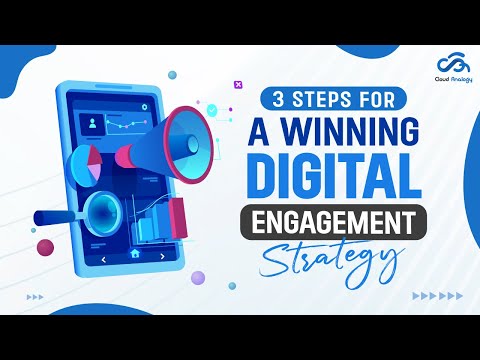As we march into 2024, businesses are discovering that a digital engagement strategy has become more than just an accessory—it’s essential. In a world where consumers wield incredible power and choice, a well-crafted strategy can ignite genuine connections with customers. It’s not just about making a sale; it’s about building a relationship that lasts long after the transaction. This article digs deep into the key components of a successful digital engagement strategy, drawing on real-world examples and innovative practices that lift brands above the noise.

Top 7 Essential Components of an Effective Digital Engagement Strategy

1. Personalization: The Heart of Engagement
Personalization isn’t just a nice touch; it’s the pulse of effective interaction. When brands tailor their messages and offers to individual preferences, they win over customers. Take Netflix, for instance. With its super-smart algorithms, Netflix studies your viewing habits and personalizes recommendations that keep you glued to your screen. This approach doesn’t just boost viewer retention— it cultivates the intimate feeling that Netflix knows you.
Personalization is seen in other sectors too. Brands like Amazon often send tailored product suggestions based on past purchases. This creates a feeling of being understood, which helps foster loyalty. Personal connection doesn’t just happen. It takes a thoughtful digital engagement strategy to make it prevalent.
2. Omni-Channel Communication: Ensuring Seamless Interactions
Seamless communication is critical in today’s digital landscape. An omni-channel strategy ensures that customers can interact with brands effortlessly, regardless of the platform. Starbucks shines in this area, integrating its mobile app, website, and physical locations to provide a cohesive experience. Customers can order from the app, collect rewards, and receive vaulting promotions suited to what they like best.
This everyday convenience transforms mundane coffee runs into personalized journeys. When businesses map out their digital engagement strategy, they must work ruthlessly to connect every channel. Consumers today expect that level of service, and those who deliver will stand out.
3. Engaging Content: Capturing Attention and Driving Interaction
If content is king, then engaging content is its crown jewel. Brands like Nike go beyond high-quality visuals to share inspiring stories that resonate deeply with customers. The famous “Dream Crazier” campaign spotlighting female athletes isn’t just about athleticism; it sparks conversations and builds emotional connections.
Engagement comes alive through storytelling that aligns with customers’ lives. It’s this type of content that grabs attention, fuels conversation, and encourages interaction. Brands that invest in compelling content will find that it pays off wonderfully—fostering loyalty and deepening customer relationships.
4. User-Generated Content (UGC): Amplifying Authenticity
User-generated content is perhaps the most genuine form of engagement. When brands encourage consumers to create content, they’re inviting conversations that can amplify authenticity. GoPro nails this with its user-generated clips showcasing breathtaking adventures caught on camera.
This not only builds a community of passionate fans—it creates trust as prospects are drawn to the organic experiences shared by real users. That authenticity resonates louder than any advertisement ever could. Integration of UGC within a digital engagement strategy can create a sense of belonging and shared experience among customers.
5. Community Building: Creating Longevity Through Connection
Building a community around a brand turns casual customers into enthusiastic advocates. As an example, Peloton welcomes its users to lively classes and empowering forums where they can unite over shared experiences.
This creates a network where customers connect, share achievements, and motivate each other. It redefines the relationship between the brand and its customers, turning transactions into lasting bonds. In focusing on community building, brands solidify their positions in customers’ minds.
6. Data-Driven Insights: Leveraging Analytics for Improvement
The power of data can’t be overstated in a digital engagement strategy. Companies like Amazon leverage analytics to peek into customer behaviors. By analyzing purchasing patterns, they not only suggest products but also create a more customized shopping experience. This adaptability enhances engagement and ensures customers feel valued.
Modern technology makes it easier to track interactions, but it takes analytical prowess to act on that data effectively. Brands that prioritize data-driven insights are often the ones that lead the pack in meeting consumer needs head-on.
7. Feedback Loops: Listening for Continuous Evolution
In today’s fast-paced market, being receptive to feedback is crucial. Zappos exemplifies this with their intense focus on customer service. Their agile response to feedback through surveys and social platforms ensures they stay in tune with customer needs.
Such frameworks of interaction create a two-way dialogue that highlights a brand’s commitment to improvement. A well-rounded digital engagement strategy employs feedback loops as a foundation for ongoing evolution, demonstrating that customer opinions genuinely matter.

Innovative Tools and Techniques for Implementation
To fully support a digital engagement strategy, businesses should consider leveraging innovative tools. Artificial intelligence (AI) platforms can streamline customer service through chatbots, offering personalized assistance round-the-clock. What’s more, implementing customer relationship management (CRM) systems, like HubSpot, lets you monitor interactions and engagement levels meticulously.
These empower companies to roll with the punches and adjust their approaches. Implementing tech means more than just keeping up; it’s about positioning to seize opportunities when they arise.

Final Thoughts on Digital Engagement Strategy
2024 is knocking at the door, presenting challenges but also tremendous opportunities for brands willing to adapt. A digital engagement strategy grounded in personalization, community building, and data-driven insights can elevate a brand and nurture lasting relationships. Prioritizing authentic interactions and harnessing technology are the keys for businesses keen to carve out a distinct identity amid fierce competition.
Engaging customers goes beyond just a strategy; it’s a necessity. As the market continues to shift, those who embrace these principles will be the torchbearers leading the charge, fostering unmatched customer connections that stand the test of time.
Feel free to consider the insights of brand activation Speakers and emotional intelligence Speakers for guidance in tailoring your approach to engagement. Stay informed and adaptable with updates like Cohasset news to keep your strategies relevant. And remember, in leadership, resilience tips the scale, a lesson from the resilience in leadership conversations that shape thoughts for success in turbulent times.

Digital Engagement Strategy: Fun Trivia and Interesting Facts
The Evolution of Customer Connections
Have you ever thought about how digital engagement strategy came to be? Once upon a time, businesses relied heavily on traditional methods like print ads and face-to-face interactions. But in today’s fast-paced environment, brands have to step it up! You might find it fascinating that just like whales can be spotted off the coast of Florida, brands are now peeking into the vast ocean of digital tools to connect with customers. A solid digital engagement strategy can truly make waves and lead to remarkable customer loyalty.
The Impact of Historical Context
Speaking of strategy, did you know that even historical events influence current practices? Take the Seven Days War for instance; it reshaped conflict dynamics and taught us about swift adaptability, a lesson vital for crafting a digital engagement strategy in fast-changing markets. Similarly, brands need to adapt their approaches based on trends and customer feedback. This just goes to show that good strategies often have roots in historical contexts, making history a great teacher as well.
The Challenges of Engagement
Now, let’s not sugarcoat it — achieving effective digital engagement can be a bit tricky. Think of it as tackling a tough issue, kind of like figuring out the potential dangers of using bongs for meth. Just as individuals must analyze risks before making decisions, businesses need to gauge their audience’s desires and preferences. A well-planned digital engagement strategy takes the scary out of customer connection by marrying analytics with genuine interaction. When you put your heart into it, you’re likely to see rewarding interactions and customer relationships bloom like spring flowers!
In summary, whether you’re reflecting on history’s lessons, enjoying the natural wonders of wildlife, or investigating pressing issues, a successful digital engagement strategy always connects the dots. To get the best results, brands should keep exploring and questioning things like Should I be worried about Underwriting?, keeping open channels for customer feedback and dialogue. This way, they’re engaging effectively and keeping a pulse on customer needs and concerns!

What is a digital engagement plan?
A digital engagement plan is a blueprint for how a business will connect with its audience through various digital channels. It outlines the strategies and tactics aimed at building and maintaining relationships with customers online, ensuring that communications are engaging and relevant.
What are the 4 pillars of digital strategy?
The four pillars of digital strategy include organizational transformation, transitioning from traditional waterfall processes to agile methods, creating a customer-centered approach, and adopting and integrating new technologies that enhance business performance.
What is a digital engagement strategy job description?
A digital engagement strategy job description typically involves coordinating and managing daily content across multiple platforms, including email, websites, social media, and SMS. This role ensures all communications align with brand objectives and effectively reach the target audience.
What is the digital customer engagement theory?
Digital customer engagement theory revolves around the idea of using digital channels and technologies to build relationships with customers. It covers every interaction a business has with its clients, from initial awareness through to post-purchase support.
What are the 3 pillars of a digital plan?
The three pillars of a digital plan generally focus on strategy, technology, and content. Together, these elements form the foundation of an effective approach to engaging customers and achieving business goals.
What does digital engagement do?
Digital engagement helps businesses connect with customers, foster relationships, and improve brand loyalty. It’s all about making sure customers feel valued and involved through meaningful online interactions.
What are the three main elements of digital strategy?
The three main elements of digital strategy include understanding the target audience, creating compelling content, and utilizing the right digital channels to effectively reach and engage that audience.
What are the 4 P’s of digital transformation?
The four P’s of digital transformation are people, processes, technology, and data. These elements are crucial for businesses looking to adapt and grow in the digital landscape.
What are the 4 C’s of digital marketing?
The four C’s of digital marketing include content, context, community, and conversation. These concepts emphasize creating valuable interactions and building relationships within the digital realm.
What drives digital engagement?
Digital engagement is primarily driven by understanding customer needs, providing valuable content, and creating meaningful interactions online that resonate with the audience.
What is a digital engagement strategist?
A digital engagement strategist plays a vital role in crafting strategies that enhance customer relationships through digital channels. This person often has a deep understanding of customer behavior and market trends.
How do you plan an engagement strategy?
To plan an engagement strategy, start by identifying your target audience, determining the digital channels they use, and developing content that speaks to their needs and interests. Consistent analysis and adjustments are key for ongoing success.
How do you engage customers digitally?
You can engage customers digitally by providing valuable content, responding to inquiries promptly, using social media interactions, and personalizing communications based on customer preferences.
What is digital customer engagement role?
The digital customer engagement role is focused on creating and maintaining strong relationships with customers through digital platforms. It involves analyzing customer behavior and crafting strategies that improve customer experience and satisfaction.
What are the digital forms of customer engagement?
Digital forms of customer engagement include social media interactions, email marketing campaigns, online chats, mobile apps, and personalized website content that encourages interaction and feedback.
What should be included in an engagement plan?
An engagement plan should include target audience analysis, clear objectives, chosen digital channels, content strategies, metrics for success, and a schedule for implementation.
What is the definition of digitally engaged?
Being digitally engaged means actively participating and interacting with a brand through digital channels, such as social media, email, or websites, fostering a sense of connection and community.
How do you write a digital plan?
To write a digital plan, start by defining your goals, identifying your audience, researching relevant channels and content types, and outlining tactics and metrics for measuring success.
What is the meaning of digital plan?
A digital plan refers to a strategic approach that outlines how a business will leverage digital channels to achieve its goals. It includes everything from audience analysis to content strategies and performance metrics.


















